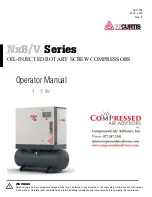
At 4002 / N
V.02.2011
31
S000012
T
est cap
Safety valve
8.
POJISTNÝ VENTIL
SAFETY VALVE
SICHERHEITSVENTIL
Pozor !
Nepřibližujte obličej nebo ruce proudu výtlačného vzduchu z
pojistného ventilu
.
Je to velmi nebezpečné, protože z ventilu tryská vysokotlaký
vzduch.
Zajistěte kontrolu pojistného ventilu dle platných předpisů, ale minimálně
1x měsíčně.
Upozornění !
Vezměte si bezpečnostní brýle.
Při kontrole úplně uzavřete výstupní ventily a povolte víčko pojišťovacího
ventilu. Manometr by měl při kontrole ukazovat přetlak min. 5 bar (0.5
MPa). Ventil pracuje normálně, jestliže stlačený vzduch začne unikat již
při malém povolení.
Po kontrole nezapomeňte víčko opět pevně zašroubovat !
Warning !
Keep face or hand away from the discharging outlet of safety valve.
It is very dangerous because high-pressure compressed air jets out.
Be sure to check the safety valve performance once a month.
Caution !
Wear safety glasses.
Close the service valve completely and turn the test cap of the safety valve to
check the performance. Discharge pressure gauge should be min. 5 bar (0.5
MPa) when you check the performance. It is performing normally when the
pressure inside the safety valve jets out with a little turn.
After check tighten the test cap again.
Warnung !
Das Gesicht und die Hände vom Druckluftstrom aus dem Sicherheitsventil
fernhalten.
Es ist sehr gefährlich, weil aus dem Ventil Hochdruckluft strömt.
Sorgen Sie für regelmäßige Kontrolle des Sicherheitsventils entsprechend den
gültigen Vorschriften, mindestens jedoch 1 x im Monat.
Hinweis !
Schutzbrille tragen.
Bei der Kontrolle schließen Sie ganz die Ausgangsventile und lösen Sie den
Verschluß des Sicherheitsventils. Der Druckmesser sollte bei der Kontrolle einen
Betriebsdruck min. 5 bar (0.5 MPa) zeigen. Das Ventil arbeitet normal, wenn die
Druckluft schon beim kleinen Lösen entweicht..
Vergessen Sie nicht, den Verschluß nach der Kontrolle wieder fest anzuziehen.












































